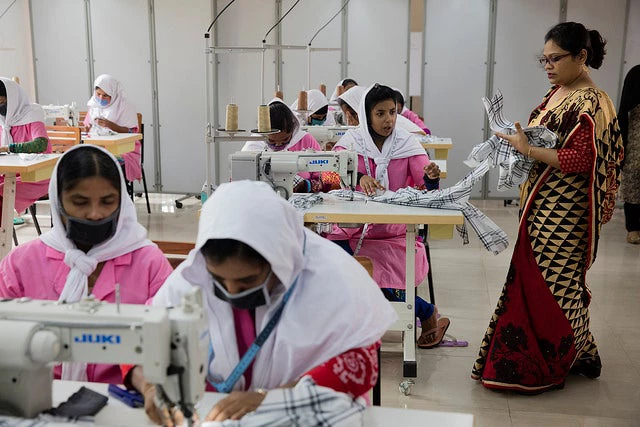An instructor at the Savar EPZ training center in Dhaka, Bangladesh, helps young women being trained to make shirts. Photo Credit: © Dominic Chavez/The World Bank
Increasing economic prosperity for developing countries is related not only to rising trade, but also – and more important – to transforming the traditional composition of what they produce and export. In the world today, many developing countries strive to diversify away from exporting commodities toward higher-value-added goods and services.
The evolution of trade and investment flows over the last three decades shows that foreign direct investment (FDI) can be a powerful driver of exports, a creator of well-paid new jobs and a crucial source of financing. More important, FDI may become a very rapid and effective engine to promote the transfer of technology, know-how and new business practices, helping to raise productivity and setting a country on the course of convergence. This is particularly the case of efficiency-seeking FDI – that is, FDI that locates productive processes in a country seeking to enhance its ability to better compete in international markets-.
The benefits of FDI are further leveraged when local firms can catalyze the presence of foreign investors to connect to global and regional value chains (GVCs). As a result of new international firms investing in a host country, great new opportunities arise for local enterprises to supply the inputs – be it goods or services – that their international counterparts need.
This has been the experience of Bangladesh, where local suppliers have grown in tandem with foreign investors in the garment sector. It is through linkages with international investors that local firms can gradually be lured into producing new goods and services that, until then, were not produced in the host country. This is how economic diversification and greater value added are generated.
Multinational enterprises (MNEs) and their key partners (Tier 1 suppliers) are generally keen to source locally if a competitive local supplier can be found. However, they are also reluctant to absorb high search-and-find costs, and they will typically not invest in assisting local suppliers with upgrading efforts. Likewise, local firms are generally keen to supply to foreign firms, but are often not ready to make the necessary investments in technology and in processes to meet strict quality standards without a clear line of sight on potential payoff for such investment.
Thus, there is a role for government policy to help de-risk this process for both the MNE and the domestic supplier, through (for example) overcoming information failures and the coordination of targeted supplier development programs to close the standards gap.
But not any policy, however well-intentioned, will work. There’s a caveat: As foreign enterprises investing abroad are competing in international markets, and as their survival depends on world-class levels of efficiency and productivity, they need to source their inputs from equally competitive suppliers. Here is the crux of a successful linkages policy: Rather than forcing foreign firms to lower their standards, governments must find ways to support domestic producers – who may have only served, until then, local markets – to upgrade production standards and practices to enable them to provide the internationally competitive goods and services that foreign firms require.
Clearly, turning local firms into international-league players is not an easy task. As in real life, becoming a world-class competitor entails means, talent, know-how, hard work and appropriate training to perform. Just as there is no quick way to become a world-class competitor in any area, there are no shortcuts to enable domestic firms becoming world-class suppliers. Occasionally, governments have tried to use laws and regulations to force shortcuts, imposing mandatory performance requirements to force world-class players to source locally, even if local suppliers in the host country cannot provide the quantity, quality or price needed.
Such policies may have been tolerated in natural-resource-seeking or market-seeking investment, where access to natural resources or domestic markets – rather than competing in international markets – were the main motivations behind investors’ locational decisions. However, in an era of GVCs, where international firms must compete in the world league, forcing such mandatory local-content policies through laws and regulations does not work in the long run. In the end, these mandatory local-content policies not only prevent linkages from happening, but may also be counterproductive: They can scare the anchor investment away from establishing in the country, or they can promote a market of corrupt practices in order to seem to comply, on paper, with the mandatory requirements.
The question arises as to what governments can do to effectively foster linkages between international and domestic investors. An effective FDI linkages strategy should interlace the needs and capacity of foreign and local business with the right policy reforms and government initiatives. It is crucial, however, that any such intervention tackle existing constraints and not interfere with business doing business.
Clearly, different country and investment contexts call for different policy mixes. As recent research shows, emerging Southeast Asian countries like Thailand or Malaysia, which have been quite successful in attracting FDI, need a renewed policy focus on improving skills, value addition and product innovation to maximize the benefits of FDI through linkages. They also need to create a more competitive local economy, which can then become a driver for attracting additional investment. The needs of other countries may be different.
To maximize the success of market-driven strategies to accelerate local linkage formation and domestic value addition (DVA), the following elements should be taken into consideration:
- Programs should aim at enlarging the MNE footprint and increasing domestic value addition in the country – i.e., increase FDI “stickiness” by more firmly anchoring or embedding the foreign investor, based on a thorough understanding of MNE sourcing strategy and GVC structure.
- Support is to be focused on the more readily competitive local firms in specific areas relevant to the sourcing needs of foreign investors. The size or nationality of firms should not drive interventions.
- Foreign investors will be key stakeholders of linkages interventions, providing guidance to program design and implementation, along with necessary market-pull.
- The implementation of linkages interventions would focus primarily in tradable sectors (goods and services). Country characteristics, as well as political-economy considerations, around (for example) extractives might at times justify linkages programs involving non-tradables as well.
- Support must go beyond matchmaking programs to address constraints faced by local businesses to connect to foreign firms. It is more about helping local firms achieve “qualified supplier status” with foreign companies through targeted capacity-building and upgrading interventions aimed at meeting basic MNE standards and certification requirements.
- Several government agencies will typically have to work together when designing and implementing a linkages strategy and program. A clear division of roles and responsibilities and a strong government agency leading the overall coordination and implementation is key to making these programs work.
There exist multiple objectives for linkage programs, including job creation, productivity enhancement and domestic value addition. On the more philosophical question regarding how much DVA is “good,” care must be exercised not to push against market forces in aiming to increase DVA and the MNE footprint (in a numerical, targeting manner) in a country. This means that the focus should be on promoting DVA on a competitive basis (through MNEs and their Tier 1 suppliers that are already in-country), while recognizing that MNE sourcing strategies and the way some of these GVCs are organized will imply that certain inputs will always be imported and that efficient cross-border trade must be encouraged for countries to offer an attractive platform to MNEs and effective participation in international production networks.



Join the Conversation